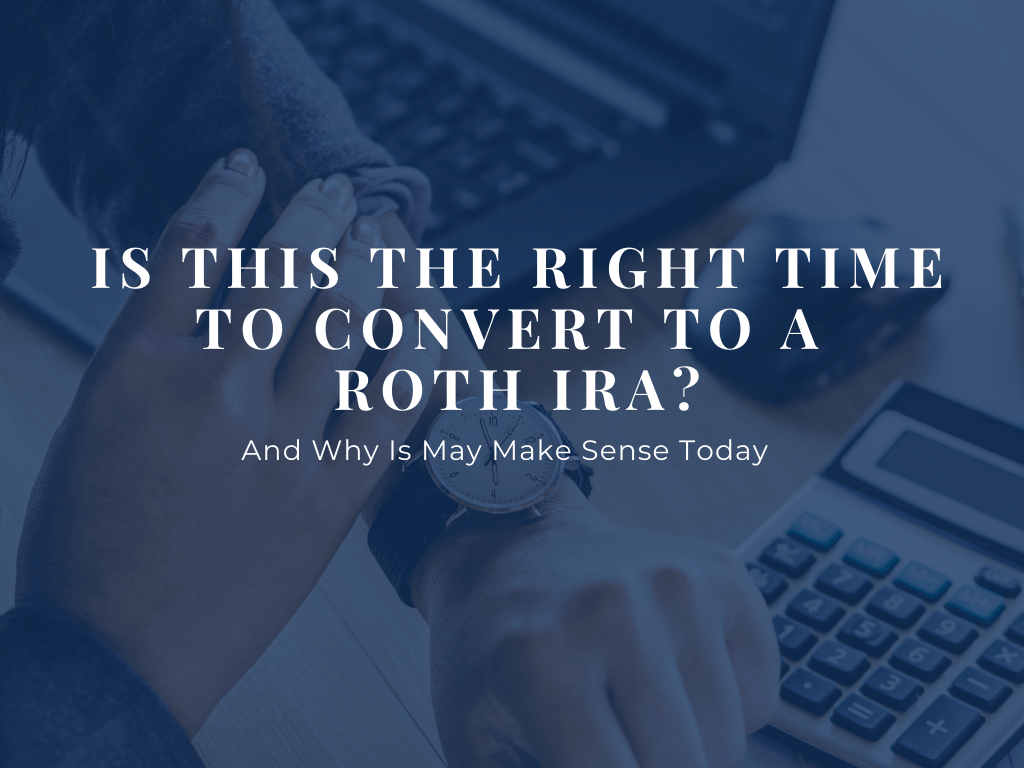
As more and more conversations come up regarding future increases to tax rates, many people are wondering, is this the right time to convert a Traditional IRA to a Roth IRA?
A number of factors in 2020 have created an environment that may make it advantageous to consider converting. The steps taken by the U.S. government to combat the COVID-19 outbreak have altered the landscape for retirement assets and how they should be allocated.
Today, IRAs are one of the primary vehicles that Americans use to fund their retirement. In fact, 43.9 million households held at least one IRA in 2017, with 35.1 million households holding Traditional IRAs and 24.9 million holding Roth IRAs, and some households holding both [Investment Company Institute]. Additionally, due to changes in the tax laws of 2010, there are no age limits or income requirements to be able to convert a Traditional IRA to a Roth IRA, but keep in mind you will have a tax liability on the amount that you convert.
How Roth IRAs Differ from Traditional IRAs
The essential difference between a Roth IRA and a Traditional IRA is the timing of taxes AND how the money grows. For Roth IRAs, taxes are paid upfront and the funds compound tax-free. That means no taxes are owed when you withdraw the funds from your Roth IRA, assuming the withdrawal is a “qualified distribution.” Generally, a withdrawal is deemed “qualified” if the Roth IRA has been established for five years AND the owner is over the age of 59 ½. For Traditional IRAs, it’s the opposite. Taxes are generally NOT paid upfront and the funds compound tax-deferred. That means you are simply deferring taxes on your Traditional IRA balance, including the earnings, until you withdraw funds.
There are two ways in which you can get funds into a Roth IRA:
1. Make a Roth IRA contribution.
However, there are limitations as to how much you can contribute and whether you’re eligible to contribute. Here are the rules:
-
- Contribution limit: $6,000 for 2020 if you are under 50 years old. Contribution limit increases to $7,000 if you are 50 years of age or older.
- Income eligibility: You are NOT eligible to contribute to a Roth IRA if your income (modified adjusted gross income, a.k.a. MAGI) is above $139,000 (single filer) or $206,000 (married filing jointly).
2. Execute a Roth conversion.
There is no limit on how much you can convert. There are no income restrictions for making a Roth conversion. However, a Roth conversion is considered a taxable event for the year in which the conversion takes place. In other words, you will owe income tax on the amount of money you convert to a Roth IRA.
Top Reasons for a Roth Conversion
The downturn in the U.S. equity markets may have come and gone but that should not preclude you from considering a Roth conversion. Contemplate the following:
- Current tax rates: The Tax Cuts and Jobs Act of 2017 lowered tax brackets and marginal tax rates for most Americans. This legislation is slated to sunset in 2025 and there is certainly no guarantee that these reductions will be retained. Given the level of fiscal stimulus provided by the CARES Act and the corresponding increase in government debt, it would hardly be shocking to see a tax increase down the road. To guard against potentially higher tax rates in the future, you might want to consider converting some or all of a Traditional IRA to a Roth IRA now. The caveat is that, in most cases, you should pay the associated taxes with your non-retirement accounts. More specifically, if you are under 59 ½ and use your Traditional IRA to pay the tax on the Roth conversion, those funds are deemed an “early withdrawal” and are subject to taxes and an additional 10% penalty. So, it is most economical to use non-retirement accounts to pay the tax.
- Impact of the SECURE Act: This legislation took effect last January and was aimed at increasing participation in tax-advantaged accounts, while preventing older Americans from outliving their assets. However, one prominent disadvantage of the act was the acceleration of income tax on Inherited Traditional IRAs. An Inherited Traditional IRA is created upon the death of the original Traditional IRA owner who then passes their IRA to a beneficiary. Historically, Inherited Traditional IRAs have been a great vehicle for beneficiaries because the “stretch IRA strategy” allowed Inherited Traditional IRA owners to “stretch” the taxation of their account over their life expectancy. Unfortunately, the SECURE Act has limited the “stretch IRA strategy” to only 10 years! So, children and grandchildren are now required to exhaust their Inherited Traditional IRAs within 10 years rather than their own lengthy life expectancies. One way of avoiding the acceleration of income taxes on Inherited Traditional IRAs is for the original IRA owner to convert to a Roth IRA now. By doing so, the next generation can have an Inherited Roth IRA in lieu of an Inherited Traditional IRA. Why is that of value to the next generation? Well, Inherited Roth IRAs are entirely tax-free!
- Lower Income in 2020: Many Americans have experienced reduced income this year because of the coronavirus. Furloughs, outright job loss and early retirements will have lowered taxable income for a sizable number of people. Remember, Roth IRA conversions are taxed at the tax rate at the time of the conversion. If your income has taken a hit this year and pushed you into a lower tax bracket, the time could be right for that Roth conversion.
- Downturn in the stock market: An ideal time to implement a Roth conversion is when the stock market is down. This is because the tax you pay on the conversion is based on the value at the time of the conversion. For example, let's say you own 100 shares of Apple in your Traditional IRA. In March of this year, Apple was trading at $60 per share. You could have converted 100 shares of Apple at $60 per share and would have to pay income tax on $6,000 ($60 x 100). That $6,000 of Apple would now be worth $11,800 in your Roth IRA. You only have to pay tax on the $6,000 conversion AND the growth since the conversion is tax-free. Bottom line, choosing to convert stock investments near the lows of the market can be a win-win.
Other Considerations and Conclusion
Given the circumstances that the 2020 pandemic has created for retirement assets, it is prudent to at least consider a Roth conversion for some retirees and those with substantial assets in a Traditional IRA. Bear in mind that these Roth conversions are irrevocable. You cannot undo a Roth conversion. Also, some taxpayers will need to be aware of how a Roth conversion might indirectly increase Medicare premiums and potentially increase the taxation of Social Security benefits.
When considering a Roth conversion, it is always advisable to consult with your CPA or tax advisor as well as a Registered Investment Adviser. We are capable of addressing the components of a conversion and how it will impact you and your family.
 About Our Author Bryan Backburn
About Our Author Bryan Backburn
Bryan Blackburn serves as Financial Planner and Wealth Advisor. As a CERTIFIED FINANCIAL PLANNER™, he manages relationships for select clients. Bryan provides holistic financial planning advice; including retirement planning, cash flow analysis, tax planning, education funding, and estate planning and investment analysis. Working in tandem with a Carnegie Portfolio Manager, he is able to provide comprehensive wealth management solutions for clients.
Looking for a Financial Advisor for You?
If you are currently looking for help with financial planning, contact us. We are happy to schedule an introductory meeting at your convenience.
Disclosure: This was prepared by Carnegie Investment Counsel (“Carnegie”), a federally registered investment adviser under the Investment Advisers Act of 1940. The information is provided as of the date indicated and believed to be reliable. Carnegie assumes no obligation to update this information, or to advise on further developments relating to it. This is prepared for informational purposes only and should not be construed as personalized tax or investment advice. Carnegie does not provide tax advice or services.



